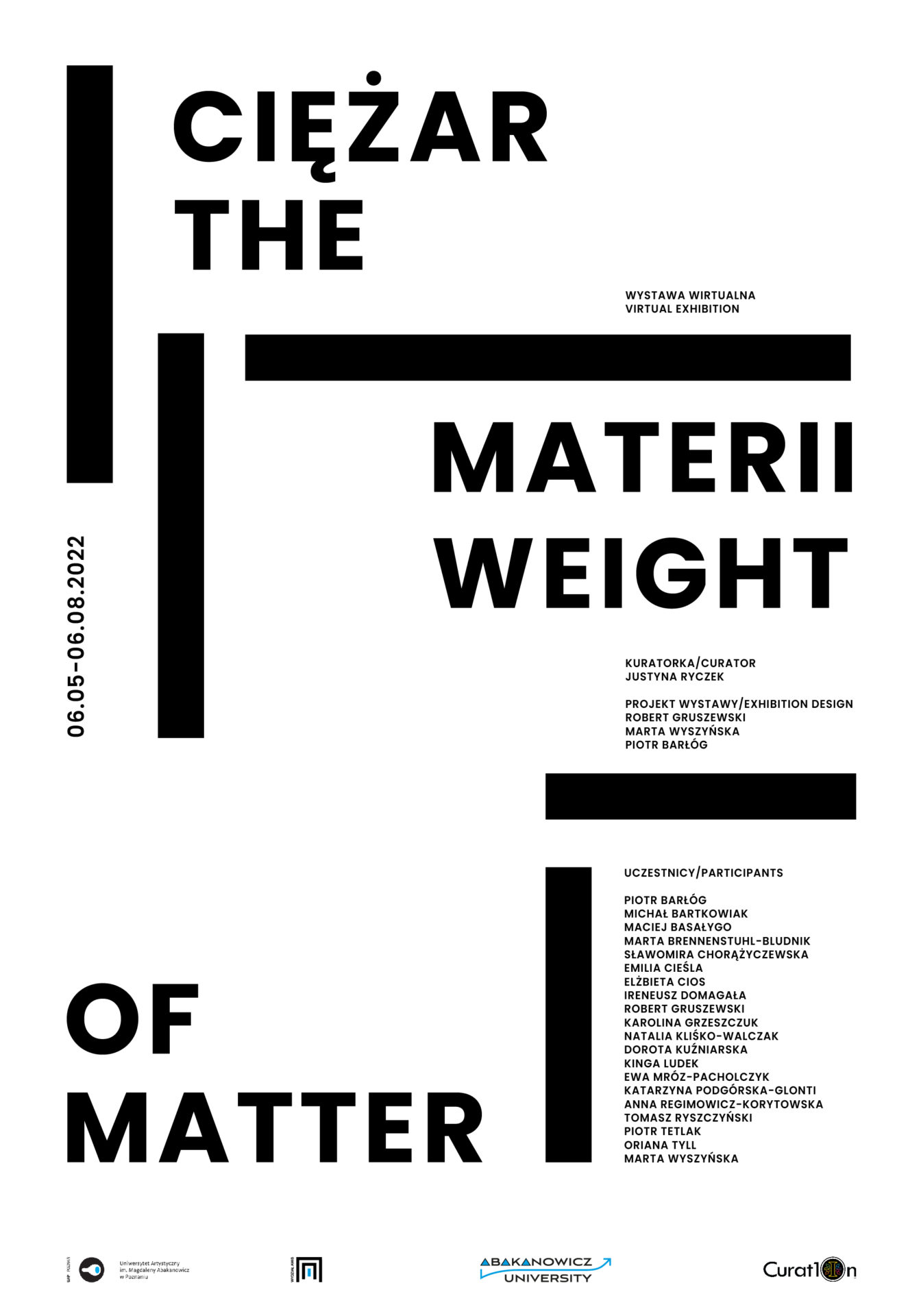CIĘŻAR MATERII | THE WEIGHT OF MATTER
WYSTAWA WIRTUALNA | VIRTUAL EXHIBITION
06.05-06.08.2022
https://portal.furioos.com/embed/cQiNvmtZhaqphco99?whiteLabel=true&hideTitle=true
KURATORKA/CURATOR: JUSTYNA RYCZEK
PROJEKT WYSTAWY/EXHIBITION DESIGN
ROBERT GRUSZEWSKI
MARTA WYSZYŃSKA
PIOTR BARŁÓG
UCZESTNICY / PARTICIPANTS
PIOTR BARŁÓG
MICHAŁ BARTKOWIAK
MACIEJ BASAŁYGO
MARTA BRENNENSTUHL-BLUDNIK
SŁAWOMIRA CHORĄŻYCZEWSKA
EMILIA CIEŚLA
ELŻBIETA CIOS
IRENEUSZ DOMAGAŁA
ROBERT GRUSZEWSKI
KAROLINA GRZESZCZUK
NATALIA KLIŚKO-WALCZAK
DOROTA KUŹNIARSKA
KINGA LUDEK
EWA MRÓZ-PACHOLCZYK
KATARZYNA PODGÓRSKA-GLONTI
ANNA REGIMOWICZ-KORYTOWSKA
TOMASZ RYSZCZYŃSKI
PIOTR TETLAK
ORIANA TYLL
MARTA WYSZYŃSKA
Otaczający nas świat współtworzy materia. Często zapominamy o niej i podążamy za wyznaczonymi celami. Tymczasem materialność nie pozwala o sobie zapomnieć. Stanowi przeszkodę albo ułatwienie w zbieraniu doświadczeń, w tym doświadczeń twórczych. Pracujemy z materią, z różnorodnymi materiałami, które mają swoje konkretne właściwości. Są miękkie, delikatne, chropowate czy nieprzyjemne, wytrzymałe i kruche. Na ile materialność materiału jest ważna, na ile zachęca do poszukiwań i eksperymentów? Czy nie za bardzo przyzwyczailiśmy się pracować z danym materiałem i bierzemy w nawias aspekt materialny? Bezpośredniość świadomego doświadczania pozwala poczuć na nowo, ale jednocześnie nie przekreśla zapamiętanego w ciele wieloletniego wspólnego tworzenia.
Materialności świata doświadczamy każdego dnia, dotykamy, gładzimy, czy przepychamy poszczególne przedmioty. Wszyscy jesteśmy otoczeni rzeczami, które w czasach pandemicznego zamknięcia stały się substytutem naszego całego świata. Zamknięcie i wirtualne przedłużenie naszej egzystencji, pokazało jak ważny jest bezpośredni kontakt nie tylko z drugą osobą, ale z realnym, fizycznie istniejącym przedmiotem czy miejscem. A może w czasie zamknięcia jeszcze więcej doświadczaliśmy materialności – materialności wszystkich urządzeń, które pozwalały nam być gdzie indziej niż nasze fizyczne, materialne ciała.
Gdy myślimy o otaczającej nas materii, często zapominamy, że człowiek również jest bytem materialnym. Ma ciało, które z jednej strony ogranicza i blokuje, z drugiej otwiera się na różnorodne możliwości. Materia – to również ja i Ty. Ciało i fizyczność, niedogodności i ograniczenia, ale także potencjalność i otwarcie.
Inspiracje pozwalające zwrócić się ku materii płyną również z rozważań filozoficznych. Nowy materializm – to hasło pojawiające się wielokrotnie. Karen Barad podkreśla, że materia nie jest już bierną substancją świata, statycznym bytem, ale interaktywnym stawaniem się, to „aktywny «podmiot sprawczości» procesu ciągłej materializacji”1.
Projektanci i architekci także zwracają uwagę na zmysłowy kontakt ze światem zewnętrznym i ważność materiału, czyni tak Juhani Pallasmaa nieustannie podkreślając zmysłowe odbieranie architektury.
Przywołane powyżej aspekty materii, to tylko niektóre z możliwych jej rozumień.
Ciężar również nie jest jednoznaczny. Może być trudnością konieczną do przezwyciężenia, ale może oznaczać ważność i znaczenie.
Ciężar materii – to wystawa artystek i artystów z Wydziału Architektury Wnętrz i Scenografii. Ich realizacje ujawniają wielowymiarowość materialności. Pokazują jej konkretność i nieokreśloność. Dodatkowo wirtualność prezentacji poszerza rozumienie materialności i kreuje nowe pole eksperymentowania. Doświadczanie wystawy pozwala na podążanie indywidulanymi drogami, zatem ciężar materii – to otwarte hasło do własnych poszukiwań – nie tylko artystycznych.
Justyna Ryczek
1K. Barad, Posthumanistyczna performatywność: ku zrozumieniu, jak materia zaczyna mieć znaczenie, tł. J. Bednarek, Teorie wywrotowe, red. A. Gajewska, Poznań 2012, s. 349
The Weight of Matter
The world around us is co-created by matter. We often forget about it while we follow our goals. Meanwhile, the materiality does not allow us to forget about itself. The materiality can consist an obstacle or facilitate collection of experiences, including creative experiences. We work with matter, with a variety of materials which have their own specific properties each.
They are soft, delicate, coarse or unpleasant, durable or fragile. How important is the materiality, how much does it encourage the research and the experimentation? Aren’t we too used to working with a given material and we push the materiality into the background? The directness of the conscious experience allows us to feel anew but at the same time it does not cancel out the long-term joint creation remembered by the body.
We experience the materiality of the world every day, we touch, stroke or push individual objects. We are all surrounded by things that have become substitutes for our entire world during the pandemic lockdown. The closure and virtual extension of our existence have shown the importance of the direct contact not only with another person, but with a real, physically existing object or place. Or perhaps during the lockdown we have experienced even more materiality – the materiality of all devices that allowed us to be elsewhere than our physical, material bodies. When we think about the materials that surround us, we often forget that the man is also a material being. It has a body that, on the one hand, limits and blocks, and on the other hand, opens up to a variety of possibilities. Material is also me and you. Body and physicality, inconvenience and limitations, but also potential and openness.
Inspirations allowing us to turn to matter also come from philosophical considerations. New materialism – this is a slogan that appears many times. Karen Barad emphasizes that matter is no longer a passive substance of the world, a static being but an interactive becoming, it is an “active «subject causative» in the process of continuous materialisation”1. Designers and architects also pay attention to the sensual contact with the outside world and the importance of the material, like Juhani Pallasmaa continually emphasising the sensual perception of the architecture.
The above-mentioned aspects of matter are just some of its possible understandings. The weight is also ambiguous. It may denote a difficulty to overcome, but it can also mean an importance and a significance.
The Weight of Matter – is an exhibition of artists from the Faculty of Interior Design and Scenography. Their realisations reveal the multidimensionality of the materiality.
They show its specificity and indeterminacy. Additionally, the virtuality of the presentation broadens the understanding of the materiality and creates a new field of experimentation. Experiencing the exhibition allows you to follow individual paths, so the weight of matter – this is an open door to your own research – not only artistic.
Justyna Ryczek
1K. Barad, Posthumanistyczna performatywność: ku zrozumieniu, jak materia zaczyna mieć znaczenie, tł. J. Bednarek, Teorie wywrotowe, red. A. Gajewska, Poznań 2012, s. 349

- Autor: Piotr Grzywacz
- Opublikowano: 06.05.2022, 08:57
- Ostatnia edycja: 20.05.2022, 10:57

